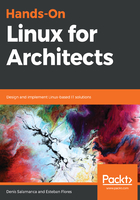
Conventions used
There are a number of text conventions used throughout this book.
CodeInText: Indicates code words in text, database table names, folder names, filenames, file extensions, pathnames, dummy URLs, user input, and Twitter handles. Here is an example: "The two key points in this command are the address-prefix flag and the subnet-prefix flag."
A block of code is set as follows:
apiVersion: v1
kind: PersistentVolumeClaim
metadata:
name: gluster-pvc
spec:
accessModes:
- ReadWriteMany
resources:
requests:
storage: 1Gi
When we wish to draw your attention to a particular part of a code block, the relevant lines or items are set in bold:
SHELL ["/bin/bash", "-c"]
RUN echo "Hello I'm using bash"
Any command-line input or output is written as follows:
yum install -y zfs
Bold: Indicates a new term, an important word, or words that you see onscreen. For example, words in menus or dialog boxes appear in the text like this. Here is an example: "To confirm that data is being sent to the cluster, go to Discover on the kibana screen"